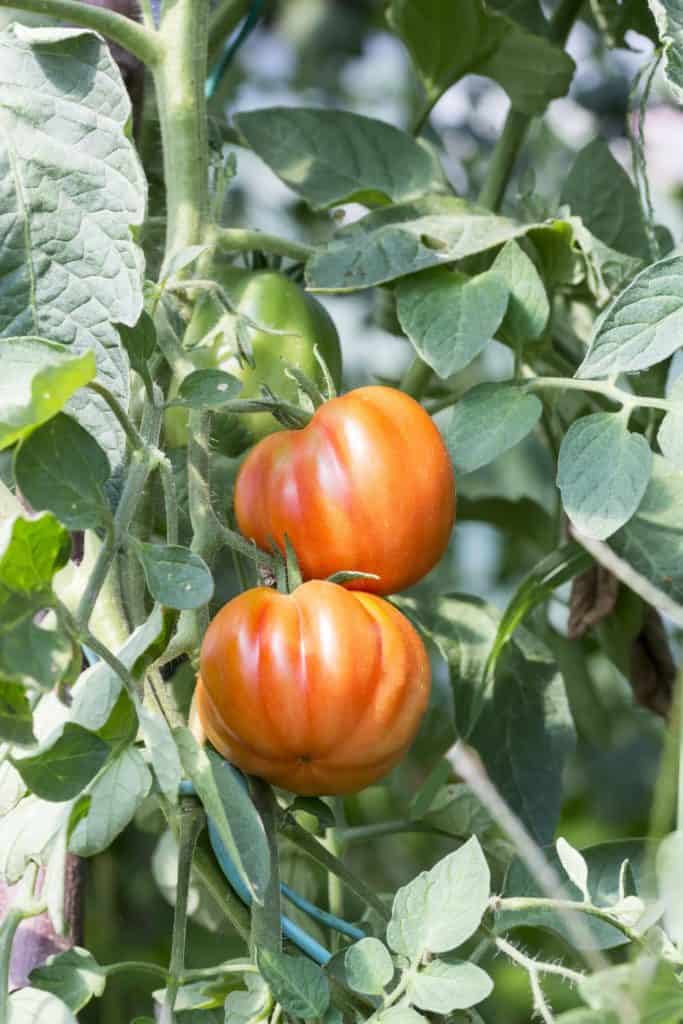If you don’t prefer homegrown tomatoes over supermarket-bought tomatoes then there’s something wrong. Homegrown tomatoes are just so much… MORE!
It might seem a little early to be planting your tomatoes in mid-March but you should certainly be thinking about it.
Among the key aspects to growing tomatoes successfully in Texas, and anywhere else for that matter, is all down to the timing.
If you get this wrong – you plant too soon, an early spring/ late fall frost can wipe out your entire crop. If you wait around for too long and you’ll likely find that your crop will not establish itself enough before the late spring heat sets in. If that occurs you’ll very likely not get any fruit.
So the first thing you want to do is head on over to your local garden center or to your local hardware store and get yourself some starter tomato plants. Add some potting soil to your shopping list and if you haven’t any one-gallon (at least one gallon) pots, you can grab some of those at the same time.

For the most part, whether it’s a garden center or a hardware store, you’ll find starter tomato plants in 4-inch pots. Ideal size.
Once you get home, you’ll want to get your new tomato plants out of the 4 inchers and into something larger. Ideally, you’ll want containers that are at least one gallon in size. You’ll also want these containers to have plenty of drainage holes in the base.
Now, point worth noting is that unlike the vast majority of other plants, tomato plants like to be planted deeply. Why so? It’s because this helps your plants to establish a larger and stronger root system.
That said, plant your tomatoes right up to the first leaves. Pinch those two leaves off before planting.
The potting soil should be well-draining and should have a pH that is slightly acidic – ideally between pH 6.2 and 6.8.
Be mindful of the weather over the coming few weeks.
On warm days, position your tomatoes outdoors in a spot that gets plenty of sunshine.
On days when the temperature gets pretty low – anything at or below 35 degrees – you’ll want to bring your plants indoors to give them protection.
You’ll want to water your tomatoes a couple of times each week. Don’t allow the potting soil to become dry.
It’s recommended to feed your tomatoes once weekly with a liquid feed. If you prefer, go for a granular fertilizer that is slow releasing.
For the most part, you’ll be fine training your tomatoes to a single stake. Unless, that is, the tomato plants you’ve chosen are indeterminate and very vigorous. In which case once they are in the ground, you’d be better off with a cage for each tomato plant.
Once you’re confident that there’s no danger of any frost (which in Texas is typically around mid-March), you can plant your tomatoes in your garden.

Soil
Tomatoes? Well, they are deep rooting and they are heavy feeders.
To do best they’ll want a quality, well-drained soil.
Chances are your soil is not ideal but you can make it as close to ideal.
If your soil is sandy it will lack the capacity to hold onto water and nutrients. If you plant your tomatoes in very sandy soil they will be prone to blossom-end rot. That’s because the roots will not get enough calcium to the fruits.
Further, in sandy soils, tomato plants can suffer more than in other types of soils from dry spells. They’ll lack the overall nutrients required for optimal growth and healthy fruit production.
On the other hand, clay soil can be very heavy and poorly aerated. Clay soils do hold onto moisture and nutrients far better than sandy soils. But drainage in clay soils can be problematic. Tomatoes do not like their roots to be sitting in water.
Sandy soils and clay soils can be managed to make them appropriate for tomato crops. The key is to add plenty of organic matter.
Add garden compost or manure that is well-rotted in copious supply – several inches thick over the entire area you’ll be planting your tomatoes. Mix this into the soil. Microbial soil activity will aid the ‘mixing’ process.
You can build up your growing beds to around 8 to 10 inches in height in order to better facilitate drainage. It’s easy enough to add more water but you can’t take it away.
In eastern areas of Texas raised beds are more important. That’s because in the east it’s not unusual to experience extended springtime deluges. Furthermore, raised beds become warmer faster which is important in ensuring your crop gets going faster.
It’s not too difficult to grow an excellent crop of tomatoes in Texas. And following these basic steps will ensure that your crop is off to an excellent start.

